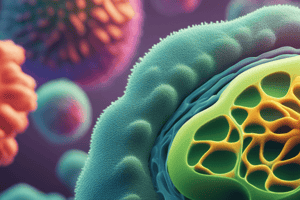Podcast
Questions and Answers
What is the theory that describes the origin of mitochondria and chloroplasts in eukaryotic cells?
What is the theory that describes the origin of mitochondria and chloroplasts in eukaryotic cells?
- Germ theory
- Cell theory
- Endosymbiotic theory (correct)
- Fluid mosaic model
Which characteristic does not apply to the structure of the plasma membrane?
Which characteristic does not apply to the structure of the plasma membrane?
- It is rigid and static in structure. (correct)
- It is selectively permeable.
- It contains phospholipids and proteins.
- It contains cholesterol in animal cells.
Which of the following structures plays a crucial role in the synthesis of proteins?
Which of the following structures plays a crucial role in the synthesis of proteins?
- Ribosomes (correct)
- Lysosomes
- Peroxisomes
- Mitochondria
The term describing the movement of molecules from an area of higher concentration to an area of lower concentration without energy is called?
The term describing the movement of molecules from an area of higher concentration to an area of lower concentration without energy is called?
Which statement about the rough endoplasmic reticulum is accurate?
Which statement about the rough endoplasmic reticulum is accurate?
Which of the following statements best describes the function of the central vacuole in plant cells?
Which of the following statements best describes the function of the central vacuole in plant cells?
The structures that enable certain bacteria to adhere to surfaces and are involved in the formation of biofilms are called:
The structures that enable certain bacteria to adhere to surfaces and are involved in the formation of biofilms are called:
Which of the following is not true of the nuclear envelope?
Which of the following is not true of the nuclear envelope?
The function of the nucleolus is to:
The function of the nucleolus is to:
Which of the following organelles is most directly involved in the synthesis of proteins?
Which of the following organelles is most directly involved in the synthesis of proteins?
Which of the following is not a function of the eukaryotic cytoskeleton?
Which of the following is not a function of the eukaryotic cytoskeleton?
The organelle that is primarily involved in the synthesis of lipids and detoxification of harmful substances is the:
The organelle that is primarily involved in the synthesis of lipids and detoxification of harmful substances is the:
Which of the following statements is true about chloroplasts?
Which of the following statements is true about chloroplasts?
Flashcards are hidden until you start studying
Study Notes
Central Vacuole in Plant Cells
- Central vacuole stores water, nutrients, and waste products.
Bacterial Structures
- Fimbriae enable certain bacteria to adhere to surfaces and assist in biofilm formation.
Nuclear Envelope
- Nuclear envelope is a double membrane structure, has pores for material passage, and is continuous with the endoplasmic reticulum.
Nucleolus Function
- Nucleolus is responsible for producing ribosomal RNA (rRNA).
Protein Synthesis
- Ribosomes are the primary organelles involved in protein synthesis.
Cytoskeleton Functions
- Eukaryotic cytoskeleton maintains cell shape, assists in movement, and supports organelles, but does not synthesize proteins.
Smooth Endoplasmic Reticulum
- Smooth endoplasmic reticulum is involved in lipid synthesis and detoxification of harmful substances.
Chloroplasts
- Chloroplasts are found in plant cells and some protists, contain their own DNA, and are the site of photosynthesis.
Citric Acid Cycle
- The citric acid cycle occurs in mitochondria of eukaryotic cells.
Endosymbiotic Theory
- The endosymbiotic theory explains the origin of mitochondria and chloroplasts in eukaryotic cells.
Plasma Membrane Characteristics
- Plasma membrane is selectively permeable, contains phospholipids and proteins, and has cholesterol in animal cells; however, it is not rigid and static.
Structures in Protein Synthesis
- Ribosomes are key structures involved in protein synthesis alongside rough endoplasmic reticulum.
Molecule Movement
- Diffusion is the movement of molecules from an area of higher concentration to an area of lower concentration without using energy.
Rough Endoplasmic Reticulum
- Rough endoplasmic reticulum has ribosomes on its surface, is involved in protein synthesis, and is continuous with the nuclear envelope.
Studying That Suits You
Use AI to generate personalized quizzes and flashcards to suit your learning preferences.




